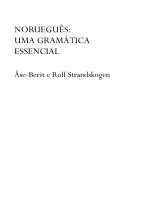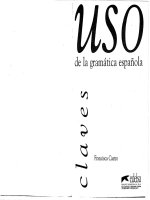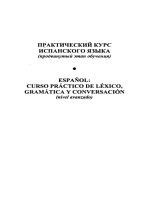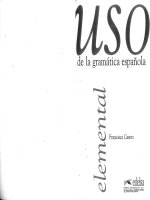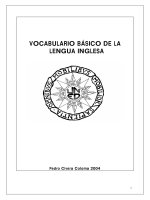Gramatica inglesa
Bạn đang xem bản rút gọn của tài liệu. Xem và tải ngay bản đầy đủ của tài liệu tại đây (543.08 KB, 93 trang )
GRAMÁTICA
4
4
GRAMMAR
“WE TRANSPORT IN ENGLISH”
1. EL PRESENTE (Simple Present)
Se forma en inglés con el infinitivo del verbo sin ‘to’ (forma básica) para todas
las personas, a excepción de la tercera persona singular que añade una -s final:
I work
You work
He works
She works
It works
We work
You work
They work
Variación de las terminaciones en la tercera persona del singular:
-s,
-ss,
-sh,
-o,
‘-es’ I go ? She goes
-ch,
-x
‘y’ precedida de consonante
14
‘ies’ I study ? he studies
LIBRO DE GRAMÁTICA
“WE TRANSPORT IN ENGLISH”
1.1. Formas Negativa, Interrogativa E Interrogativa-Negativa
Para su construcción se recurre al verbo ‘to do’ que realiza una función auxiliar. En la tercera persona la forma ‘do’ cambia a ‘does’.
Oraciones negativas:
sujeto + auxiliar + not + forma básica
I do not work
You do not work
He / she / it does not work
We do not work
You do not work
They do not work
Oraciones interrogativas:
auxiliar + sujeto + forma básica
Do I work?
Do you work?
Does he work?
Do we work?
Do you work?
Do they work?
Oraciones interrogativo-negativas:
auxiliar + sujeto + not + forma básica
Don’t you work?
Doesn’t he work?
GRAMMAR HANDBOOK
15
“WE TRANSPORT IN ENGLISH”
1.2. Usos Del Presente Simple
a) Para indicar acciones o estados habituales
He works in an office
El trabaja en una oficina. No se trata de si está trabajando en este momento,
sino que lo que se indica es que es una persona que habitualmente trabaja en
una officina.
b) Dado que se emplea para indicar acciones o estados habituales, suele
acompañarse de los adverbios de tiempo (usually, sometimes, never, etc.).
We never work on Saturday
c) Puede indicar una acción indeterminada en el tiempo:
I speak English
16
LIBRO DE GRAMÁTICA
“WE TRANSPORT IN ENGLISH”
2. EL PRESENTE CONTINUO (present continuous)
El presente continuo o progresivo se forma con el presente del auxiliar ‘to be’ y
el gerundio del verbo que se quiere conjugar:
presente
forma negativa
I am working
You are working
He is working
We are working
You are working
They are working
I am not working
You are not working
He is not working
We are not working
You are not working
They are not working
forma
interrogativa
forma
interrogativanegativa
Am I working?
Are you working?
Is he working?
Aren’t you working?
Are we working?
Are you working?
Are they working?
2.1. Uso Del Presente Continuo
a) Indica una acción que se está desarrollando en ese momento.
He is working
Está trabajando en este momento.
La diferencia con el presente simple: He works está clara. El presente continuo indica que está trabajando en ese momento concreto. El presente simple
indica que habitualmente trabaja pero no sabemos si lo está haciendo en ese
momento.
b) También puede indicar una acción planificada que se desarrollará en un
futuro. (ver el futuro)
I am working tomorrow
c) Puede indicar una acción habitual que se repite frecuentemente. En este
caso, suele acompañarse de adverbios de frecuencia (‘often’, ‘usually’, etc.)
She is always working
GRAMMAR HANDBOOK
17
“WE TRANSPORT IN ENGLISH”
2.2. Simple present – present continuous
Usamos el Simple Present para hablar de:
Usamos el Present Continuous para hablar sobre:
»»Cosas que son siempre ciertas
»»Cosas que ocurren a veces, normalmente, a menudo, etc.
»»Cosas que están ocurriendo en el momento de hablar
»»Cosas que están ocurriendo o cambiendo actual,ente
»»Situaciones temporales
18
LIBRO DE GRAMÁTICA
“WE TRANSPORT IN ENGLISH”
3. EL PASADO SIMPLE (Simple Past)
El pasado simple funciona de manera similar al Presente simple, salvo que
empleamos el auxiliar ‘did’ para todas las personas (incluida la tercera persona singular ‘he/she/it’). En la forma afirmativa, el auxiliar ‘did’ no aparece, empleando en su lugar la terminación ‘ed’. Esta es la forma de pasado para todos
los ‘Verbos Regulares’
Existe un amplio conjunto de verbos que no cumplen esta condición, es decir,
para la forma afirmativa no emplean la terminación ‘ed’ sino que su forma es
irregular. No siguen ninguna regla, por lo que la única manera de conocer su
forma de pasado es aprenderla. Se denominan ‘Verbos Irregulares’. (ver lista
de verbos irregulares)
3.1. Afirmativa
Sujeto + verbo en pasado
I worked
You worked
He worked
We worked
You worked
They worked
3.2. Negativa
Sujeto + auxiliar de pasado (did) + not + verbo en infinitivo
I did not work
You did not work
He did not work
We did not work
You did not work
They did not work
GRAMMAR HANDBOOK
19
“WE TRANSPORT IN ENGLISH”
3.3. Interrogativa
Auxiliar did + sujeto + verbo en infinitivo
Did I work?
Did you work?
Did he work?
Did we work?
Did you work?
Did they work?
3.4. Uso Del Pasado Simple
a) Para acciones pasadas. Indican el período de tiempo durante el que se desarrolló y completó una acción ya finalizada. Es habitual que vaya acompañado de un adverbio de tiempo.
I worked for IBM last year
b) Para expresar una acción indeterminada en el pasado:
They worked hard
c) Para expresar una acción habitual en el pasado
She always arrived late at work
d) Puede servir para expresar una condición improbable. (ver oraciones condicionales)
If she worked here, I would recognize her
20
LIBRO DE GRAMÁTICA
“WE TRANSPORT IN ENGLISH”
4. EL PASADO CONTINUO (Past Continuous)
Su estructura se forma con el pasado del verbo auxiliar to be + el gerundio del
verbo que se quiere conjugar.
I was working
Para la forma negativa se añade la ‘not’ al auxiliar
I was not working
En la forma interrogativa se invierte el orden del sujeto y el auxiliar:
Were you working?
Uso Del Pasado Continuo
a) Usamos el pasado continuo para decir que alguien estaba haciendo algo en
un momento concreto del pasado. Por ejemplo:
Yesterday Tom and Jim played tennis. They began at 10 o’clock and
finished at 11 o’clock.
What were they doing at 10.30? They were playing tennis (at 10.30)
‘They were playing’ quiere decir que estaban en medio de la partida, habían
empezado pero no habían acabado.
El pasado continuo no nos dice si la acción estaba finalizada o no. Compara:
Tom was cooking the dinner. (past continuous)
= estaba a medias y no sabemos si había finalizado
Tom cooked the dinner. (past simple)
= empezó y acabó.
GRAMMAR HANDBOOK
21
“WE TRANSPORT IN ENGLISH”
b) Para expresar dos acciones que se desarrollan simultáneamente
I was working at the office while she was shopping.
c) A menudo usamos el pasado continuo (I was doing) y el pasado simple (I did)
juntos para expresar dos acciones que se desarrollan en el pasado, una de las
cuales tuvo su comienzo antes que la otra.:
Tom burnt his hand when he was cooking the dinner.
While I was working in the garden, I hurt my back.
Pero para decir que los acontecimientos ocurrieron uno despues de otro usamos el pasado simple:
Yesterday evening Tom was having a bath when the phone rang. He got
out of the bath and answered the phone.
(Primero salió y después contesto el teléfono)
22
LIBRO DE GRAMÁTICA
“WE TRANSPORT IN ENGLISH”
5. EL PRESENTE PERFECTO (Present Perfect)
El presente perfecto, se forma con el presente del verbo ‘to have’ a modo de
auxiliar y el participio pasivo del verbo que se conjuga según la siguiente construcción:
to have + participio del verbo a conjugar
I have worked
You have worked
He has worked
We have worked
You have worked
They have worked
La forma interrogativa, se obtiene anteponiendo el auxiliar al sujeto.
Have you worked?
En la forma negativa se coloca ‘not’ después del auxiliar:
He has not worked
La forma interrogativa-negativa tiene la construcción auxiliar + not + sujeto
Haven’t you worked?
Uso Del Presente Perfecto
a) El ‘present perfect simple’ conecta / une el pasado y el presente. Si decimos
que algo ha ocurrido (‘has happened’), pensamos del pasado y del presente a
la vez como si hiciesemos un puente del pasado al presente.
I have lost my pen
b) A menudo usamos el presente perfecto para dar una información nueva o
para anunciar un acontecimiento reciente
I’ve lost my key. Can you help me look for it?
GRAMMAR HANDBOOK
23
“WE TRANSPORT IN ENGLISH”
c) El presente perfecto y el pasado simple. El presente perfecto siempre nos
dice algo sobre el presente:
Un cliente llama y pregunta por Mr. Dean. Decimos:
He has gone to the conference (y ahora está ahí)
El pasado simple sólo nos habla sobre el pasado:
He went to the conference at 9.00 (no sabemos si todavía está ahí o no)
Nunca se debe usar el presente perfecto para hablar de acciones que no están
conectadas con el presente
Cervantes wrote “El Quijote”
d) Usamos el present perfect simple para acciones en el pasado que tienen un
significado o relevancia en la actualidad.
A: I have lost my portable computer and I don’t have the information you
need
(acción en el pasado que tiene un significado ahora)
B: Really?
A: I lost my portable computer last year
(ahora no importa)
24
LIBRO DE GRAMÁTICA
“WE TRANSPORT IN ENGLISH”
6. EL PRESENTE PERFECTO PROGRESIVO (Present Perfect
Continuous)
Tiene la siguiente construcción:
sujeto + presente perfecto de ‘to be’ + gerundio
forma afirmativa
I have been working
En la forma negativa se coloca ‘not’ después del auxiliar:
I have not been working
La forma interrogativa, se construye invirtiendo la posición del sujeto y el auxiliar:
Have you been working?
La forma interrogativa-negativa sigue la misma construcción que en el presente perfecto
Haven’t yo been working?
Uso Del Presente Perfecto Progresivo
Se usa cuando se quiere expresar el sentido de la continuidad de una acción
que ha comenzado en el pasado, que dura todavía en el presente y que incluso
puede continuar en el futuro.
I have been working here for two years
(y continúo trabajando en la actualidad)
GRAMMAR HANDBOOK
25
“WE TRANSPORT IN ENGLISH”
7. TIME EXPRESSIONS (expresiones temporales)
a) Ever and never
El ‘present perfect’ es usado frecuentemente con esta expresión temporal
Have you ever been to Scotland?
I’ve never studied English.
b) Just
El ‘present perfect’ es usado frecuentemente con esta expresión temporal (=
“acabar de hacer algo”)
I’ve just finished the report
c) Recently and lately
El ‘present perfect’ es usado frecuentemente con esta expresión temporal
I’ve recently met Mr Green, the sales manager of Speedy Transport
Have you seen Andrew lately?
d) So far
El ‘present perfect’ es usado frecuentemente con esta expresión temporal
I’ve had three pone calls so far this morning and it’s only eight o’clock!
26
LIBRO DE GRAMÁTICA
“WE TRANSPORT IN ENGLISH”
e) Still, Yet and already
El ‘present perfect’ es usado frecuentemente con estas expresiones temporales
‘yet’ - normalmente se utiliza en frases interrogativas y normalmente se colaca
al final de la oración . Se usa cuando esperamos que algo pase en el futuro, no
en el pasado ni en el presente.
Have you finished the report yet?
I don’t think Mathew has finished the report yet.
‘already’ - se usa en frases afirmativas e interrogativas y normalmente va detrás de los verbos auxiliares o modales y delante de los demás verbos. Con
‘already’ decimos que algo está en el presente o el pasado, no en el futuro. Lo
usamos para decir que algo ha ocurrido antes de lo esperado.
Don’t forget to finish the report, will you?
Yes, I’ve already finished the report
“Still” - se utiliza para hablar de cosas que están ocurriendo ahora. Normalmente se situa antes del verbo principal y después del verbo auxiliar.
It ‘s still snowing
En Inglés británico yet y already acompaña habitualmente a los tiempos perfectos. En Inglés Americano prefieren usar los tiempos pasados.
Compara:
Have you phoned Mr Drew yet? (UK) Did you phone Mr Drew yet? (USA)
I’ve already phoned him (UK) I already phoned him (USA)
GRAMMAR HANDBOOK
27
“WE TRANSPORT IN ENGLISH”
f) Since, for and ago
Since y for se usan para referirse a la duración de un estado o acontecimiento.
El ‘present perfect’ es usado frecuentemente con estasexpresiones temporales.
‘For’ - (how long something has lasted) Se usa para decir cuánto tiempo ha durado una acción. En español suele decirse ‘desde hace’ o “durante”. Se puede
usar para:
Expresar la duración de un tiempo en el pasado:
He worked as a systems analyst for three years
Expresar un período de tiempo que empezó en el pasado y dura hasta el presente:
We’ve had this computer for about six months.
O con referencia al futuro:
I will be staying in Dubai for two months
‘Since’ - (when something started) Se usa como una referencia a un punto de
tiempo cuando algo empezó. En español suele decirse ‘desde’ o ‘desde que’.
We haven’t heard from you since April.
Since se utiliza después de la expresión temporal “It’s + expresión temporal”
It’s a long time since we saw each other
“ago” - se utiliza `para señalar cuando ocurrieron los acontecimientos en el
pasado haciendo una cuenta atrás hasta el presente
She finished five minutes ago
Comparar:
I’ve known Mary since 2001.
I’ve known Mary for 3 years.
I met Mary three years ago.
28
LIBRO DE GRAMÁTICA
“WE TRANSPORT IN ENGLISH”
g) During and while
During se utiliza para señalar que algo ocurre dentro de un período de tiempo.
Va seguido de una frase nominal que empieza por “the” o un posesivo. “during”
During the week I’m extremely busy
While es parecido en significado con during pero va seguido de un sujeto y un
verbo “mientras”
I met Mr Holmes while I was visiting the Trade Centre
(=durinng my visit to the Trade Centre)
GRAMMAR HANDBOOK
29
“WE TRANSPORT IN ENGLISH”
8. EL PLURAL (plurals)
Como norma general, el plural se forma añadiendo -s a la forma singular:
table 4 tables
EXCEPCIONES
»»Cuando la palabra termina en s, ss, x, ch, sh se le añade -es al final.
Bus 4 Buses
box 4 boxes
Church 4 churches
Dish 4 dishes
»»Cuando termina en o precedida de consonante se le añade -es también,
aunque hay algunas excepciones (palabras de origen no inglés, como piano, pianos)
Tomato 4 tomatoes
Potato 4 potatoes
»»Cuando terminan en y precedida de consonante se sustituye la y por la terminación ies.
lorry 4 lorries
»»Algunas palabras que terminan en f o fe cambian la f / fe por -ves.
Thief 4 thieves
(Hay algunas excepciones a esta regla, como roof, proof, chief, safe y cliff, que
forman el plural añadiendo -s al final de la palabra)
»»Plurales irregulares
Man 4 men
30
LIBRO DE GRAMÁTICA
“WE TRANSPORT IN ENGLISH”
Woman 4 women
Child 4 children
Foot 4 feet
Tooth 4 teeth
Ox 4 oxen
Mouse 4 mice
Goose 4 geese
Louse 4 lice
Penny 4 pence
»»Algunos sustantivos tienen únicamente forma singular:
Fish
Deer
Sheep
»»Algunos sustantivos tienen solamente la forma plural
Goods (mercancias)
Scissors
Trousers
Glasses (Gafas)
Pyjamas
Clothes
Thanks
»»En los nombres compuestos (sustantivos formados por dos palabras que
juntas toman una significación única) solamente el segundo sustantivo
toma la forma de plural.
Summer holiday 4 summer holidays
»»En cambio, cuando se forman con preposiciones o adverbios el plural recae en el primer sustantivo.
Brother in law 4 brothers in law
»»OJO con los adjetivos. Recordad que únicamente tienen forma singular.
Red, Good, Easy, Beautiful ...
GRAMMAR HANDBOOK
31
“WE TRANSPORT IN ENGLISH”
9. PREPOSICIONES TEMPORALES
AT
Espacios temporales precisos
“at five o’clock”, “at dinner time”
I suggest we meet at 4.30.
fiestas - “at Christmas”
We close down at Christmas.
“at night”, “at weekends”
We’ve got the results at last. (after a long period of waiting)
ON (punto en el tiempo)
Días y fechas
“on Monday”
The quality circle meeting is on Wednesday.
“on June 1st”
The videoconference is on 3rdApril.
“on Christmas Day” , “on a Sunday morning”
Please be on time (at the right time, not late.)
IN / During (entre dos puntos de tiempo)
Períodos de tiempo más largos: meses, estaciones del año, años
“in August”, “in spring” “in the past”, “in 1985”
They employ students in the summer vacation
There was, full employment in the 1960s
32
LIBRO DE GRAMÁTICA
“WE TRANSPORT IN ENGLISH”
Periodos de tiempo durante los cuales o al final de los cuales algo puede pasar
“in five minutes”
I didn’t send my application in time to be considered. (it arrived too late to
be considered}
ABOUT (aproximadamente)
The job will take about a week.
AROUND (aproximadamente)
She’ll be there around 5 o’clock.
BEYOND (limite en la duración)
It’s impossible to extend credit beyond the 60 days agreed.
BY (limite en el tiempo)
The plane leaves at 10 so we must be at the airport by 9 a.m.
FROM (punto de partida en el tiempo)
The exhibition will be open from 1 June.
THROUGH (dirección dentro de un tiempo)
I’ll be staying in Chicago May through June. (AmE)
I worked all through my lunch-break.
TO (dirección futura)
It’s seven minutes to three.
There are only two weeks to the symposium.
The office is open from 9 to 5.30 (= until)
GRAMMAR HANDBOOK
33
“WE TRANSPORT IN ENGLISH”
10. PREPOSICIONES DE LUGAR (Prepositions of place)
About (posción aproximada)
I’ve left the folder lying about somewhere.
Around
The Accounts Department is around the corner.
At (lugar)
At is used when we talk about position at a point
When we regard a place as a point –without any real size- we use at. It is a point
and the size of the place is not important.
My house is at the third crossroads after the bridgeI live in Bicester
(a place)
The train stops at Bicester
(a point on a journey)
He’s staying at the DorchesterHe spent Saturday afternoon at work
“En este punto”
Meet somebody at the station
Se considera un punto de encuentro
My sister works at Marks & Spencer
Se refiere al “punto” en el que trabaja, no al espacio físico
I’ll meet you at Gatwick airport.
At (dirección)
We’ve aimed our campaign at the young urban professional.
34
LIBRO DE GRAMÁTICA
“WE TRANSPORT IN ENGLISH”
Beyond (limite en la dirección)
We cannot transport the goods beyond the Pakistani frontier.
By (cerca de)
The warehouse is by the canal.
From (origen)
The video recorders are imported from Taiwan.
On a line (espacio o linea en dos dimensiones))
Usamos on para decir que algo está tocando o cerca de una linea o algo parecido a una línea (un río, una carretera)
The calendar is hanging on the wall.
Carlisle is on the road to Glasgow
The file is on the desk.
On también se usa para hablar de una localización fija cerca del agua
Bowness is on Lake Windermere
California is on the Pacific coast.
In (espacio tridimensional)
In se utiliza cuando el entorno es tridimensional
I think I left my tennis racket in the bathroom
The money is kept in the safe.
También se utiliza para señalar la posición sobre una superficie con valla, muro,
etc, de manera que parece cerrada.
Let’s picnic in that field over there.
Con áreas amplias (paises, regiones, etc)With larger areas
I’ve got a cottage in Jersey
GRAMMAR HANDBOOK
35
“WE TRANSPORT IN ENGLISH”
(pero “on a desert island”)
San Francisco is in California.
Through (direction between two points in space)
It can take ages to clear goods through customs.
Once we’re through Rome we’ll be able to drive faster.
To (movement, destination)
I have to go to Rabat next week.
The taxi will take you to the airport.
36
LIBRO DE GRAMÁTICA

